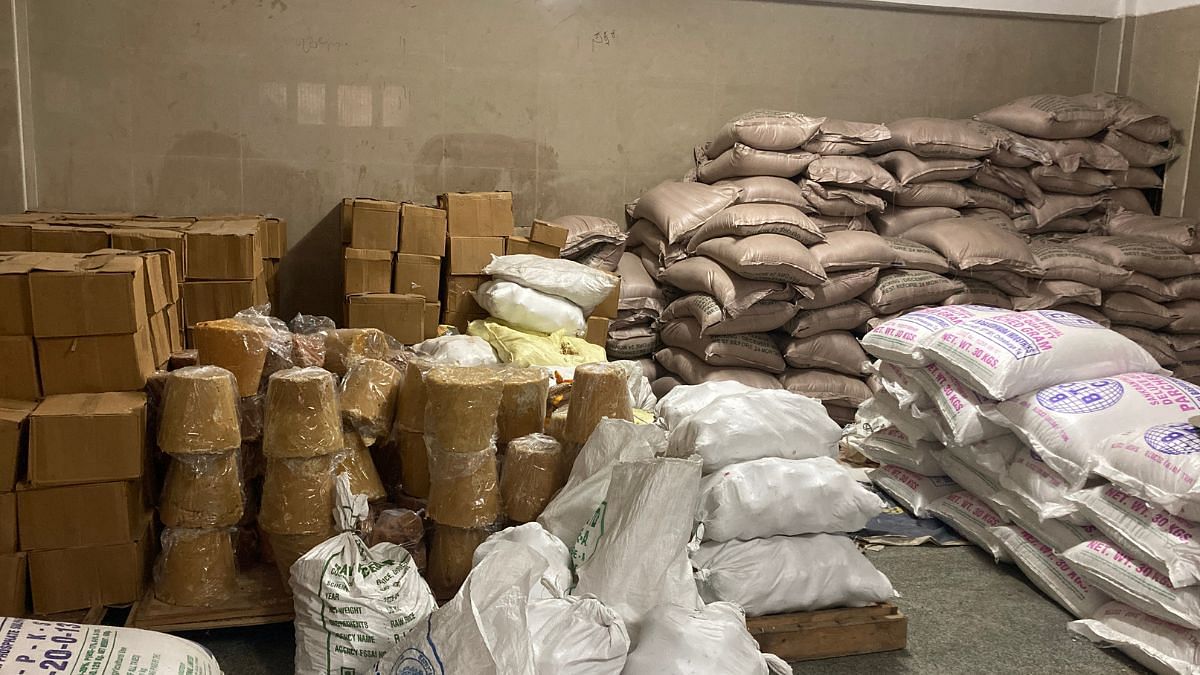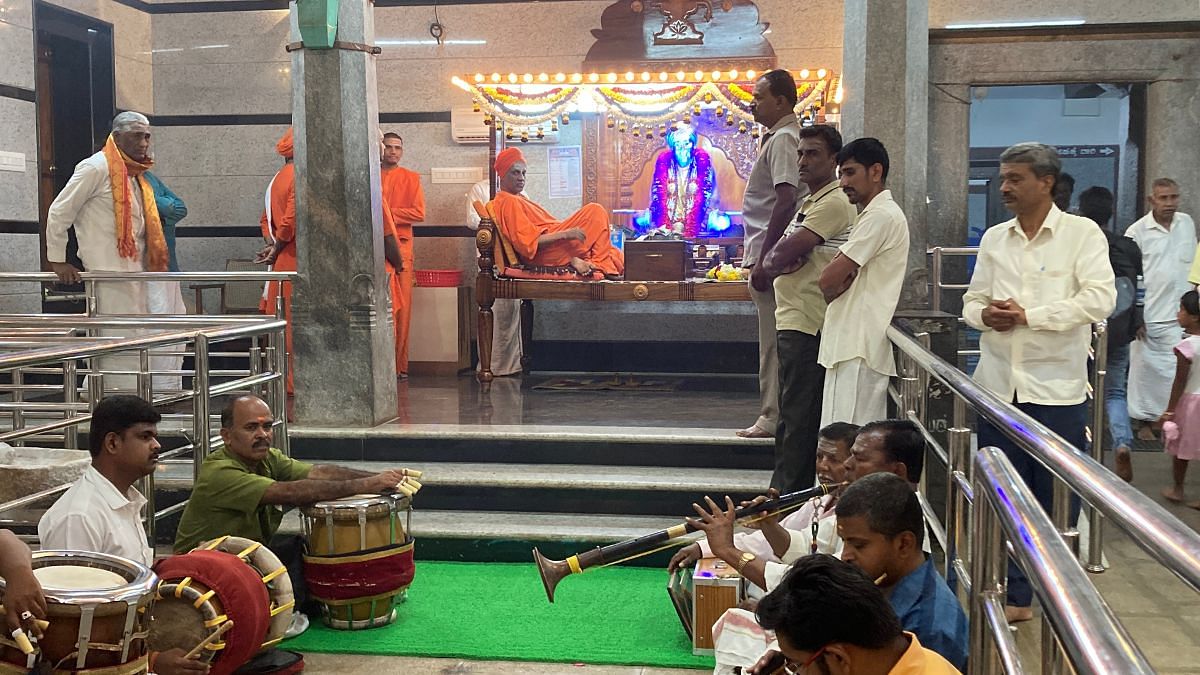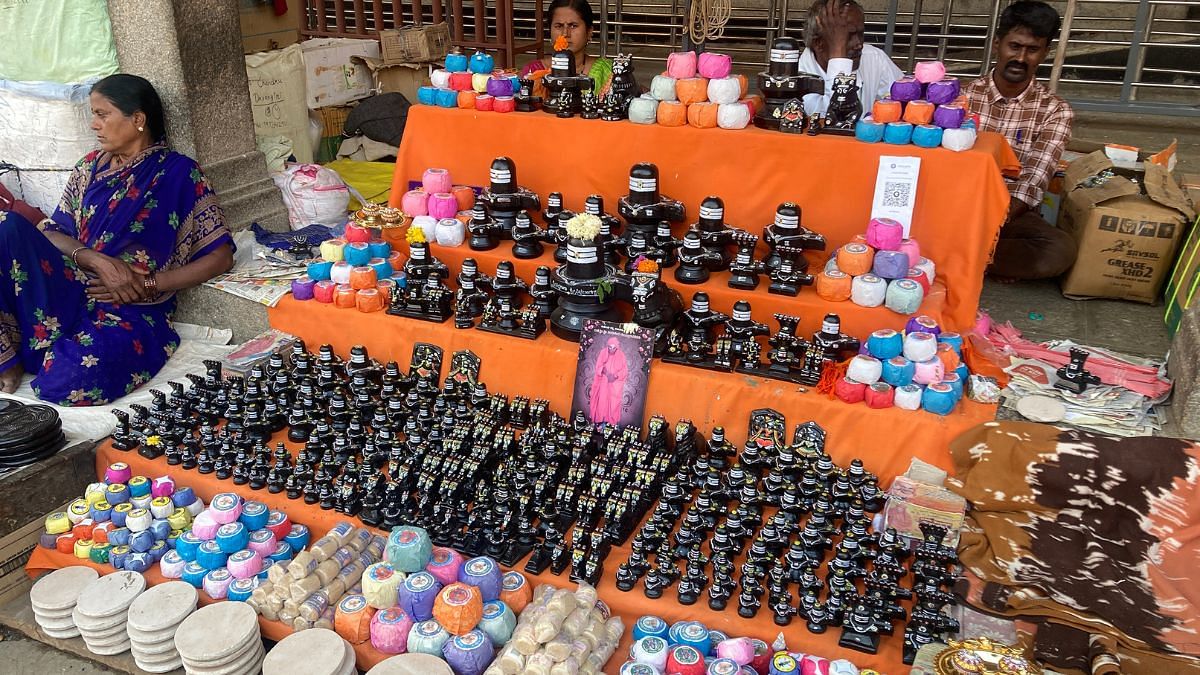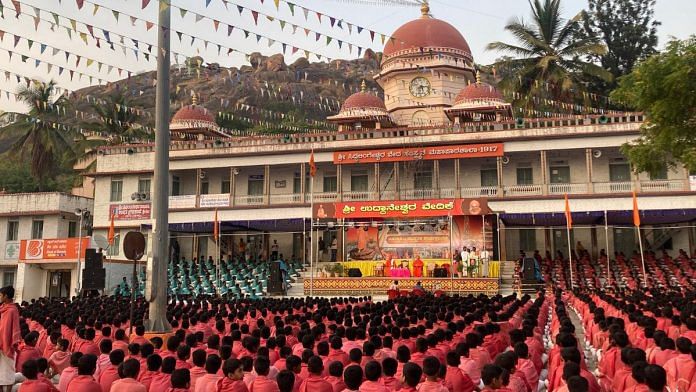Bengaluru: Two men sit at Supreme Pontiff Siddalinga Mahaswami’s feet in Tumakuru’s Siddaganga Mutt. One after the other, they hand him cheques, documents, and registers to sign. In a span of three minutes, Mahaswami signs 17 documents, including two cheques, procurement orders, and plans for a mela. He is the administrative head of the mutt, and nothing happens without his consent.
Mutts in Karnataka have a storied reputation for running like well-oiled efficient machines.
It’s a far cry from how Hindu temples are run in Karnataka, where an underfunded and overburdened Hindu Religious & Charitable Endowments (HR&CE) department struggles to keep up with maintaining nearly 35,000 temples across the state. The two-decades-old department has been caught in a political push-and-pull between successive Congress and BJP governments that have tried and failed to offer a coherent policy for how temples should be run and how much control to give and take away.
A recent amendment to increase temple tax — a move that even priests have come out in support of because it increases the income of smaller temples — has brought Karnataka back to the forefront of the movement for temple freedom across India. Introduced by the Congress, the amendment is strongly opposed by the BJP. Now, both parties are caught on a seesaw, with each accusing the other of being anti-Hindu.
Temple freedom is a seductive and powerful political slogan for the Ayodhya-fuelled BJP. But Karnataka is where the party had come closest to tweaking the complex maze of how temples are controlled but developed cold feet.
Releasing temples from government control was even mentioned in BJP’s 2018 manifesto. But it’s been a story of fits and starts. In December 2021, then Chief Minister, BJP’s Basavaraj Bommai even declared that his government would “free temples from government control”. But barely a year later, the project was shelved, and Bommai instructed his office that temples continue to be administered as they were.
Temples should be given back to Hindu society to run. In fact, there are hundreds of temples being managed so well by mathas
– Girish Bharadwaj, VHP activist & advocate
Without a clear, hard-nosed vision for implementation, temple freedom will remain a slogan in Karnataka. From Tamil Nadu to Uttarakhand, Hindu groups have raised the rallying cry for temples to be free from government control, but the simmering political dynamics have kept the religious pot from boiling over. It has proved to be an administrative black hole.
Many say that Karnataka already has a best practices model that Hindu temple administrators and politicians can learn from— the mutts themselves. The autonomously run mutts or mathas are not temples and are exempt from the purview of the HR&CE Act. But they offer a solution on how things could be run in a state that keeps considering other options.
“You can’t make money with just gods. It’s temple lands and resources that the government is eyeing,” said Bengaluru-based VHP activist and advocate Girish Bharadwaj. He added that the issue transcends political lines and that all politicians are the same when it comes to the ‘temple matter’.
“There is no concrete plan on how temples should be run — the government doesn’t have the time or resources to think about temples. Temples should be given back to Hindu society to run. In fact, there are hundreds of temples being managed so well by mathas.”
Also Read: Who should run Hindu temples? Tamil Nadu is the epicentre in new tug-of-war
The mutt model of administration
Siddaganga Mutt, easily one of Karnataka’s largest mutts, is so well managed that it recently came to the rescue of the Karnataka government. It loaned the Food and Civil Supplies Department 180 quintals of rice to feed students at an OBC hostel.

Davangere residents Manjula and Lilavati are not surprised that the government turns to mutts for help. They travelled five hours from their hometown to Tumakuru, and spent the last two nights at the mutt’s accommodation for free. They have a dual purpose at Siddaganga Mutt—they want to attend the Shivratri festival at the mutt, and more importantly, spend time with their sons.
Both women, who are from an SC community, sent their 12-year-old sons to study at Siddaganga Mutt not just because of the quality of education, but also in the hope that they would be well taken care of.
“The culture is good here, it’s safe and gives my son more exposure,” said 37-year-old Manjula. “Mathas give education and food to everyone, besides running the temple. In temples we can only go and pray to God, here there’s more for regular people.”
Mathas or mutts, as it is spelled in the HR&CE Act, offer free food, free accommodation and free education through government-aided schools. They are religious institutions run by a person whose main duty is to teach religion and philosophy associated with a particular denomination. The Siddaganga Mutt is a Lingayat institution—the Siddalingeshwara temple sits atop a hill within its premises.
“In Karnataka, mutts stand as a shield for Hindu society,” said Yashas BS, state vice-president of the youth wing of the All India Veerashaiva Mahasabha, whose family has been closely associated with the mutt for generations.
They’re self-sustaining industrial complexes that stretch beyond religion. The Siddaganga mutt in particular runs over one hundred institutions across Karnataka — mostly around Tumakuru, where the mutt is located — which include hospitals and colleges.
Mathas give education and food to everyone, besides running the temple. In temples we can only go and pray to God, here there’s more for regular people.
– Manjula, visitor and mother of a student at the Mutt
“There’s no question of the government getting involved,” said DS Nagaraju, the PRO of Siddaganga. “Mutts provide so much undeniable social service, irrespective of caste and religion. There are no irregularities that people — even the government — can target.”
Siddalinga Mahaswami, the current pontiff of Siddaganga, presides over every aspect of the mutt and its various arms—education, food, shelter, health, and the temple. It is entirely sustained by income from devotees and private functions that Mahaswami is invited to preside over. The school, which educates over 10,000 boys from all communities, is given a grant-in-aid from the government to pay teachers’ salaries. The mutt also has vast food reserves, cooking meals for the 10,000 students and the thousands of other visitors from 7 am until 11 pm every single day.
“Karnataka is one state where temple freedom is a popular political issue. One of the plausible reasons is that mutts are free,” said Kishen Shastry, a doctoral student in economics at the University of Cambridge who works on the issue. “So, across the geographic and caste spread in Karnataka, people have witnessed the impact of deregulated Hindu institutions.”
There are 4,000 mutts in the state, all autonomous and individually run. None of them come under the purview of the HR&CE department, locally known as the Muzrai department. The HR&CE Act, passed in 1997, came into force in 2003, but made no mention of the mutts.

In 2011, the Karnataka High Court struck down the Act, after which the then-BJP government, led by BS Yediyurappa, amended the Act to specifically mention mutts and the fact that they would not be regulated by the government. The irony is that before the amendment was enacted, the 2003 Act was struck down not for government overregulation, but under-regulation.
Mutts wield considerable clout in Karnataka society, and politicians often queue up for their endorsement or support before polls to gain access to mutts’ thousands of voters. Pontiffs often emerge as the most important figure of this socio-religious authority.
The Siddaganga mutt in particular is an important stop for all kinds of politicians—from Prime Minister Modi to Congress leader Rahul Gandhi—because it represents a sect of Lingayats, a powerful voting bloc in Karnataka. The previous pontiff of Siddaganga, Shivakumara Swami, who lived to the age of 112, was known for welcoming all politicians but was always careful to keep politics out of the mutt, steering clear of any affiliations.
“All political leaders come here, take swamiji’s blessings, and go,” said Vishwanathaiyya, the administration officer of the mutt. “People, including politicians, all come to our mutt and use our facilities. Since Tumkur is on the way to Bengaluru, many actually come here, refresh themselves, and then continue on their journey.”
It’s why they are integral to Karnataka society, and generally left alone to administer themselves, drawing reverence and respect from across the political spectrum.
“They [mutts] are the perfect model that shows how Hindu society can govern themselves, and still provide services to Muslims and Dalits too. And it is because the government cannot control them that they are able to do so much seva (service),” said Yashas.

Also Read: Not all Hindu temples in Uttarakhand are free. But are they for tourists or pilgrims?
Uphill battle for the department
Bengaluru’s Muzrai Department is sandwiched between a temple, a church, a hospital, and Tipu Sultan’s summer palace. Unlike its modern and palatial counterpart in Chennai, the Karnataka department shares its office space with a bank.
Chandru, a Brahmin teacher who teaches the Bhagavad Gita at the local Ramakrishna Math, is a fixture at the department. He is campaigning for the department to help find stolen idols — including a 500-year-old chariot — and restore the facade of the 1,500-year-old Someshwara Temple in Ulsoor.
“The temple has been ruined in the name of development, devotees, and donors!” said Chandru, agitatedly. “The RSS and VHP and other Hindu groups keep talking about foreign invaders who have destroyed our temples. What about temples that have been destroyed by carelessness and greed?”
He visits the department, which is in charge of overseeing 34,563 temples across the state, nearly once a week, greeting all the officials and department employees by name. His mission is clear—he wants the department to do more to preserve and protect his beloved Someshwara Temple.
But it’s an uphill battle. He knows the department doesn’t have the budget to take on the large-scale renovation and restoration the temple needs. To complicate matters, the executive officer — a government employee assigned by the department to look after temples — has filed a case against him for harassment.
Yet, Chandru won’t give up. He knows the present commissioner of the department is doing the best he can — which is why he’s recently stepped up the frequency of his visits to the department. The commissioner speaks from the heart and not from the tongue, he said.
Others don’t have as much faith in the department. Calling it “constantly sidelined”, Bharadwaj said that the government doesn’t have the budget, bandwidth or time to effectively manage the temples under its purview.
They [mutts] are the perfect model that shows how Hindu society can govern themselves, and still provide services to Muslims and Dalits too. And it is because the government cannot control them that they are able to do so much seva (service).
– Yashas BS, state vice-president of the youth wing of the All India Veerashaiva Mahasabha
The temples under its purview are split into three main categories: the largest 205 temples with incomes exceeding 25 lakhs belong to Grade A, 193 temples with incomes between 5-25 lakhs are in Grade B, and the remaining 34,165 are all Grade C temples, earning less than 5 lakhs a year.
Today, the Muzrai Department only “takes over” a temple after complaints are filed over mismanagement of funds — if the department investigates and finds the case to be true, it moves to notify the temple as public. The most recent such intervention was when devotees complained to the department that a Ganesha temple in Jayanagar 4th block was being mismanaged.

The department has had to stand strong through political winds of change, as successive governments have debated its role. Their mandate is not to control temples, according to senior officials at the department. It is simply to help manage the huge flow of money and pour it back into the temples themselves.
Plus, what makes things tricky is ensuring the sanctity of age-old traditions such as the appointment of priests and ritual customs that shape each temple’s culture.
“We’re governed by the HR&CE Act, which is for the administration and facilitation of temples in Karnataka — not control,” said HR&CE Commissioner H Basavarajendra. “But when it comes to the question of temples collecting public funds, administration becomes important.”
He added that when public funds are involved, it is essential for the government to have legislation to manage it. “It is important to have an act to administer and also interfere with requisite provisions whenever necessary, and whenever there are any complaints,” he said.
Also Read: MP Congress is courting Hindu priests. But temple land promise is going to be tricky
The political seesaw
The issue over temple administration has been a push-and-pull, a constant back-and-forth between successive governments. Even within the BJP, there have been multiple different points of view on how involved the government should be.
“My government will do it… Other than regulation, there shall be no restriction on administration or control of Hindu temples. There will be full freedom and autonomy,” then chief minister Bommai had said to loud cheers in 2021.
But a year down the line, he’d backtracked. The Muzrai department reportedly warned Bommai’s office of how complicated this could be. Not only would it run the risk of bringing back caste discrimination, but it would also be hard to redistribute temple lands. The CMO then shelved the project.
The RSS and VHP and other Hindu groups keep talking about foreign invaders who have destroyed our temples. What about temples that have been destroyed by carelessness and greed?
– Chandru, teacher
His predecessor in the BJP, Yediyurappa, is also known for being devout — so devout that his government donated Rs 110 crores of public money between 2008 and 2011 to various temples, including those in other states. His government also doubled the salaries of priests, costing the exchequer Rs 58 crores per year.
And it was also Yediyurappa’s government that first amended the HR&CE act, thirteen years before the Congress did in 2024.
The 2024 Amendment is what has brought the issue back to the limelight, but many who’ve been watching the story play out — including Akhila Karnataka Hindu Temple Archakas (Priests) Association — point to the fact that the amendment is a much-needed update that will increase the earnings of temples.

The Karnataka Hindu Religious Institutions and Charitable Endowments (Amendment) Bill was passed on February 29, days after the BJP-JD(S) defeated it in the Legislative Council. It proposes a Common Pool Fund under the Muzrai department, which will help provide more amenities to temples. Muzrai minister Ramalinga Reddy also said that the amendment will provide scholarships to children from families of priests, as well as insurance and death relief funds for priests.
Officials at the department are careful to say that the recent amendment is not a temple tax — it’s more like a ‘contribution’. The idea is to redistribute income from Grade A temples to be used for the development of Grade C temples. The amendment now requires temples that earn above Rs one crore to contribute 10 per cent of their income, and temples earning between Rs 10 lakh and one crore rupees to contribute five per cent.
“The Karnataka government is controlling Hindu temples under [the HR&CE Act], which is against Article 14, 25 and 26,” said S Prakash, spokesperson for BJP Karnataka, referring to the 2011 Karnataka High Court judgment that struck down the Act. “It should free temples from its clutches and allow Hindus to run their temples as other religions are allowed.”
Hindu groups and the BJP have been resisting the Act, accusing the government of stealing from rich temples.
But the proposed Common Pool Fund has always been a part of the Act, and the BJP’s 2011 amendment added a provision under Section 17 to collect parts of the funds generated by high-income temples and redistribute it under the Common Pool Fund. But at the time, there was a 10 per cent tax on all temples earning over Rs 10 lakh, which meant small temples with not as much income carried a higher burden of tax. The current breakup shifts the monetary burden onto wealthier temples.
Accusing the incumbent Congress government of swindling money from temples is a simple case of misinformation, according to current Muzrai minister Reddy.
What makes matters more confusing is the complicated legal history of temple administration in South India, a problem experienced by Tamil Nadu too. The notified temples under Karnataka’s Muzrai Department were all spread across the colonial presidencies of Madras, Bombay and Mysore, and passed into the hands of the state after the formation of Karnataka. Until 1997, multiple Acts governed temples — including a colonial-era Act from 1927, much like Tamil Nadu.
This is why it’s hard for Hindu society to unite against the issue, according to Hindu groups. There’s just too much obfuscation and garbled confusion.

“In the present scenario, you can either have a people’s movement to free temples or a judicial intervention,” said Bharadwaj, who has been going to court over the issue for a decade now. “Unfortunately, Hindus don’t wake up early. When you can’t mobilise people, you have to go to the judiciary. And that’s what we’re doing.”
Shastry argued that temple freedom should be looked at from an economic lens too.
“Regulation of religion by the government has unintended consequences, especially on the competitiveness of religious institutions,” said Shastry, citing work by Larry Iannaccone and Michael McBride. “India is on a high economic growth trajectory, and with it, we are likely to witness an increase in stressors towards cultural and personal issues for which religion can act as a bulwark. For instance, religion has a well-established positive impact on mental health. Hence, deregulation temples will have a long-lasting impact on society,” he said, adding that the government will need to ensure that there’s a management system in place that has the right incentives for performance.
The government would require some creative thinking to ensure a smooth transition to deregulation, if it were to happen, according to Shastry. The HR&CE Act would have to be watered down and then replaced with elected management committees that ensure caste and gender representation. This could be piloted with some Grade A temples, and then followed up with an evaluation.
“Public policy will then have some basis and not just remain mere colonial hangovers,” said Shastry.
Also Read: Bhupesh Baghel’s Kaushalya Mandir is Chattisgarh’s own Ram trail. BJP is ‘uncomfortable’
Whose temple is it anyway?
Siddaganga Mutt is insulated from this political storm.
“The greatness of Karnataka is its mutts. According to their capacity and power, they are giving service to society. That’s our tradition,” said Mahaswami. “Our focus is on inculcating good education and humanitarian values in our students to become good citizens of the country.”
Most employees at the mutt sidestep the question of whether the state’s temples should be handed over to similar administrations — that’s a political question that the government can decide. Their job is to provide quality education to try and improve society. Besides, the government provides ample support to their social welfare activities, added Mahaswami.
There are already several temples being managed by mutts — Siddaganga manages the temples within its premises, and temples in Gokarna, Sringeri and Udupi are also managed by mutts.
Mutts in Karnataka have now become the kind of public centre that temples used to be, according to both Bharadwaj and Chandru — one campaigning for temples to be freed, the other doggedly trying to get the government to intervene.
“A local body or committee should administer temples — there is no religious sanctity when it is run by those who do not know traditions. Temples were not just about God, they were centres of art, architecture, dance, learning, law…it’s where Hindus would come together and participate in society. Now what are Hindus limited to?” asked Bharadwaj. “No one has a solution for this issue. Politicians don’t have any real interest in caring for temples, and people are apathetic too.”

The movement for temple freedom in Karnataka is like being on a merry-go-round– once it stops spinning, no one knows which dizzy direction to walk in.
Either way, detractors of government involvement in temple administration agree that the onus falls on Hindu society to take good care of temples.
It’s a particular issue that Chandra is enraged by. He’s knocked on the doors of wealthy locals, Hindu groups, and the government. Only the Muzrai department is responsive, even as Chandru worries his concerns are falling on deaf ears. Once again, he returns to his complaint about how the RSS and VHP keep talking about foreign invasions of temples while temples languish in apathy.
“Everyone is blind to the state of our temples! Mahmud of Ghazni hasn’t even seen this temple,” said Chandru angrily. “My question is why can’t the RSS, BJP, VHP or Bajrang Dal at least see the temple?”
This is the third article in a series about the tug-of-war between States and temples over control of wealth and worship. Follow the series on this new temple freedom movement here.
(Edited by Theres Sudeep)



